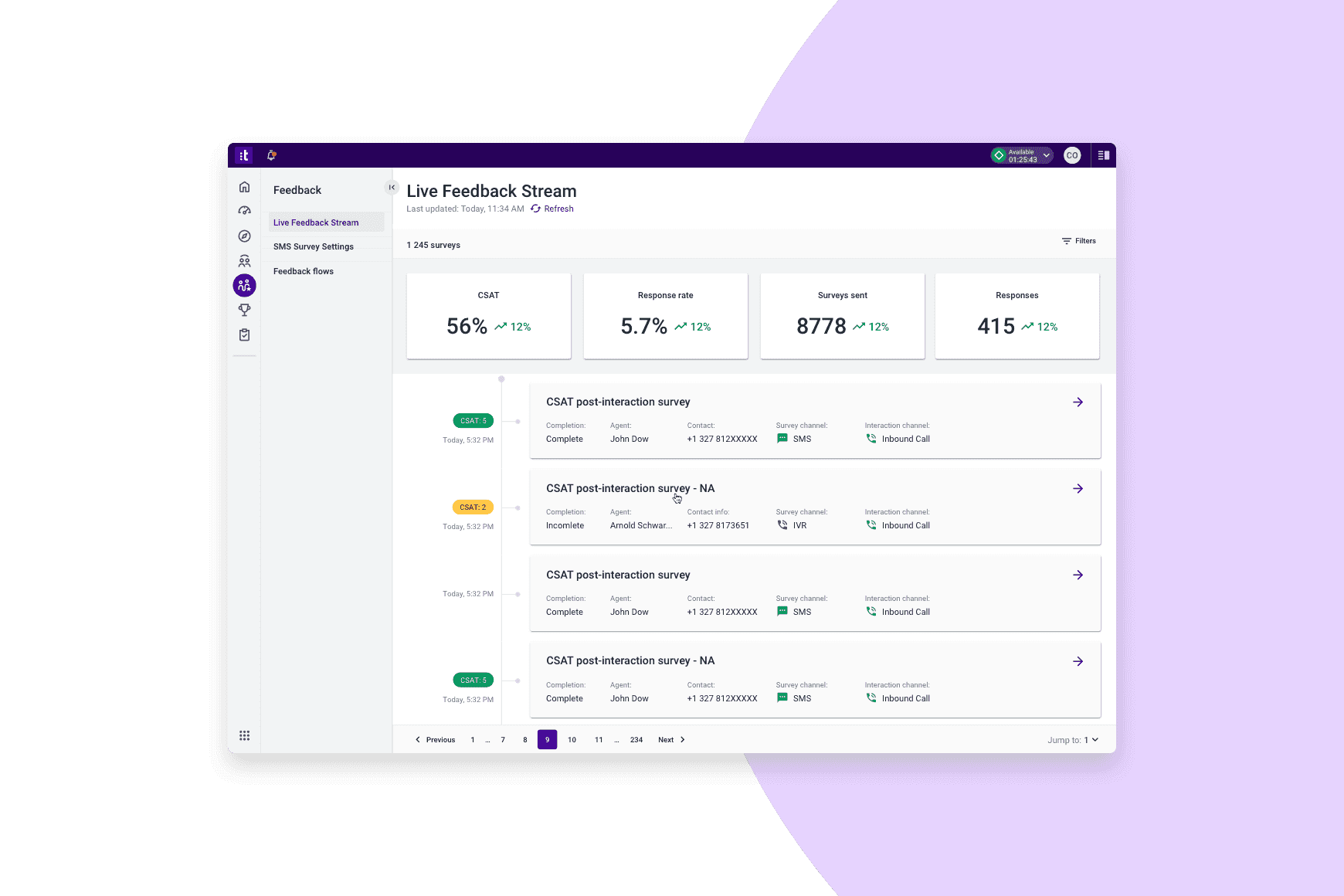4 AI-powered tools for analyzing the voice of the customer

By Celia Cerdeira
0 min read

In today’s competitive market, customer centricity is more than a buzzword, it’s a necessity. Businesses must transform the voice of the customer (VoC) from mere feedback into actionable strategies to enhance products, services, and the overall customer journey. Yet, many companies overlook this, leading to persistent issues like long wait times and poor customer satisfaction.
AI-powered tools are critical, not optional, in addressing this challenge, providing targeted insights for efficient and precise VoC analysis. Time is precious, and with data overload, these AI solutions are the key to efficient and precise VoC analysis.
In this article, we’ll dive into what voice of the customer is and how to analyze it successfully, including:
Methods for collecting customer feedback.
Collecting customer feedback can be overwhelming, particularly with a large customer base. With so many customers and ways to gather their thoughts, it may be difficult to know where to start. Here are our top five methods:
Surveys.
Surveys serve as a direct line to customer insights, and text message surveys, in particular, capitalize on this immediacy. Plus, due to the ubiquity of mobile devices, text message surveys often boast high response rates.
After a support call, a customer’s phone immediately lights up with a survey. Their input is funneled back into the business’s quality management system, allowing for data-driven decisions that refine service quality and directly impact the bottom line.
Email.
Email is one of the easiest methods to collect honest customer feedback as it is cost-effective, a widely used channel for providing support, and most people have an email account highly increasing its reaching potential.
Using an email to send a link to a feedback request form won’t be odd for customers and most of them will be willing to do it because it comes from a trusted email address and is related to something they remember.
For example, a business might send an email following a customer’s purchase or interaction, containing a link to an online feedback form. This approach is non-intrusive and taps into a communication channel that most customers are familiar with and use daily.
An email request for feedback might include a brief introductory message thanking the customer for their business, followed by a simple question asking about their experience. It may also incorporate a rating scale for quick feedback, and an open field for more detailed comments.
Customer reviews and ratings.
Customer reviews and ratings on review websites or within apps provide many insights about customer satisfaction. These reviews often contain detailed accounts of customer experiences, highlighting areas of success and potential improvement.
Importantly, these reviews also offer a public record of customer perspectives, influencing potential customers’ decisions and impacting business reputation. For example, a restaurant might monitor online reviews to identify common complaints or praise about the food, service, or atmosphere.

Report
The Global State of CX 2023
Download The Global State of CX 2023 to discover how and why customer loyalty is harder to win, and what those with the biggest CX budgets are investing in.
1:1 customer interviews.
1:1 customer interviews give businesses a deeper understanding of the customer experience. Through direct conversation, businesses can explore specific aspects of the customer journey, uncovering rich insights that may not surface in standard surveys. For instance, after launching a new product, a company might choose a diverse group of customers for interviews to get detailed feedback on the product’s features, pricing, and overall value.
These interviews also allow businesses to build stronger customer relationships, enhancing loyalty and encouraging ongoing feedback. When a business asks for a customer’s opinion, it demonstrates that the customer’s feedback is valued, which in turn fosters customer loyalty and promotes the likelihood of future feedback.
Social media monitoring.
Social media platforms, like Twitter, Facebook, and Instagram, are a goldmine of customer opinions and experiences. Businesses can gather unfiltered and real-time customer feedback by actively monitoring comments, mentions, and direct messages. This provides invaluable insights into customer preferences and pain points.
For example, a fashion retailer could monitor posts tagged with their brand to see how customers are styling their clothes, or a software company could track tweets mentioning their product to identify and resolve any user issues quickly.
Social media monitoring allows businesses to engage with customers directly, addressing concerns promptly and improving overall customer relations. Remember, each method has its strengths and is suited to different scenarios.
Four AI tools for analyzing the voice of the customer.
Leveraging AI tools can greatly enhance a business’s voice of customer analysis, allowing them to process large volumes of data quickly and accurately, leading to more precise insights and improved customer understanding. Here are four AI tools that can transform a business’s approach:
1. Advanced customer experience analytics.
Talkdesk customer experience analytics uses AI to interpret and act on customer feedback. This tool helps businesses understand customer behavior, preferences, and satisfaction levels, enabling them to make data-driven decisions. It also offers predictive capabilities, allowing companies to anticipate customer needs and proactively address potential problems before they escalate.
Beyond these capabilities, customer experience analytics also allows businesses to visualize data in intuitive dashboards, making identifying trends and patterns that could influence strategic decisions easier.
2. In-depth interaction analytics.
AI-powered interaction analytics can decode customer sentiment from interactions, providing a deeper understanding of their experiences. Talkdesk Interaction Analytics™ uses AI to analyze customer interactions and derive meaningful insights. This tool identifies patterns and trends in conversations to highlight recurring customer service issues and improvement areas.
Interaction analytics use machine learning algorithms to continually improve its understanding of customer sentiment.

INTERACTION ANALYTICS
AI interaction analytics for better customer experience
Talkdesk Interaction Analytics™ reviews customer conversations for topics and sentiment trends without setup. With generative AI, it detects emerging topics, uncovering valuable insights and opportunities—even unexpected ones.
3. Quality management enhancement.
Talkdesk QM Assist is a quality management tool that uses AI-driven insights to improve interactions. It provides searchable call transcripts and highlights key moments in customer interactions, allowing managers to gain a deeper understanding of customer sentiment. This tool also analyzes customer sentiment and automatically evaluates all calls close to real-time.
For businesses, it delivers fully automated, AI-driven interaction scoring that’s custom-tailored to their unique evaluation criteria, promoting continuous learning and development among agents. This results in improved service delivery and faster resolution of customer issues.
4. Comprehensive feedback collection.
Talkdesk Feedback gathers the voice of the customer data, providing businesses with a comprehensive view of customer opinions and experiences. This tool makes it easy to create and deploy surveys to collect, analyze, and act on customer feedback. It aggregates feedback from various channels into a single platform and uses AI to prioritize feedback based on sentiment and impact, helping businesses respond to critical issues promptly.
Talkdesk Feedback also allows businesses to close the loop with customers, acknowledging their feedback and informing them about the actions taken, leading to increased customer engagement and trust.
Best KPIs to track to measure the voice of the customer efforts.
KPIs offer businesses a clear and objective way to assess the impact of the voice of the customer initiatives on customer satisfaction and loyalty. These metrics should be analyzed with other performance indicators and customer feedback for a holistic understanding of the customer experience.
Net promoter score.
Net Promoter Score (NPS) is a widely used KPI in contact centers that measures customer loyalty. It categorizes customers into promoters, passives, and detractors based on their likelihood of recommending a brand to others. Tracking NPS allows businesses to identify the proportion of their customer base that are loyal advocates and those who are dissatisfied and could potentially harm the brand through negative word-of-mouth.
Customer satisfaction score.
On the other hand, the customer satisfaction score (CSAT) measures how satisfied customers are with a business’s products or services. It is typically captured through customer service surveys where customers rate their satisfaction on a scale. A high CSAT score indicates that customers are finding value in the brand’s offerings which can lead to increased customer retention and positive referrals.
Customer effort score.
In addition to NPS and CSAT, other KPIs can provide valuable insights into the voice of the customer’s efforts. Customer effort score (CES) measures how easy it is for customers to interact with a brand. A lower CES indicates a smooth and effortless customer experience, which can boost customer satisfaction and loyalty.
Customer churn rate.
Similarly, tracking churn rate—the percentage of customers who stop doing business with a company over a certain period—can signal dissatisfaction and help identify improvement areas.
Businesses should closely monitor these KPIs to ensure their voice of the customer efforts yield positive results. They should also make necessary adjustments to enhance customer satisfaction and loyalty to drive business growth.
The importance of understanding the voice of the customer.
Understanding the voice of the customer is crucial to enhancing customer satisfaction and driving business growth. The Talkdesk suite of tools offers a comprehensive solution for collecting and analyzing customer feedback, helping businesses make informed, data-driven decisions. Talkdesk AI-powered analytics tools simplify the process of gathering and interpreting the voice of customer data and provide actionable insights that can significantly improve customer interactions.
With these tools, businesses can proactively address customer needs, deliver superior service, and build stronger customer relationships. Ultimately, an effective voice of the customer program leads to increased customer loyalty, positive word-of-mouth, and enhanced business performance.
Talkdesk AI tools take businesses beyond just hearing their customers’ voices; they allow them to truly understand their needs and expectations to deliver superior customer experiences.
These insights empower businesses to anticipate changes in customer behavior, and preferences and ensure they always deliver relevant and personalized experiences.
Ready to harness the power of AI to improve operations? Learn more about our tools that help businesses collect, analyze, and act on the voice of the customer data.

FEEDBACK
Create and deploy customer surveys with Talkdesk Feedback
Improve customer satisfaction by gathering insights that will empower you to serve them better and increase customer loyalty.
FAQs.
What is the voice of the customer?
The voice of the customer captures customer preferences, expectations, and aversions. Essentially, it’s about understanding the customer’s needs and wants.
Capturing the voice of the customer involves collecting customer feedback through various channels, such as surveys, social media, or direct communications, and analyzing this data to derive actionable insights. Voice of the Customer aims to close the gap between customer expectations and their experience, improving customer satisfaction and loyalty.
What are the benefits of the voice of the customer analysis?
Voice of the customer analysis offers numerous benefits. At its core, it provides a deeper understanding of customer needs and preferences, acting as a compass that guides business decisions. Through identifying areas of improvement, businesses can make necessary adjustments to their products, services, or processes.
Voice of the customer analysis aids in crafting personalized customer experiences, ensuring that every interaction is relevant and valuable to the individual customer.
How can I use the voice of the customer insights to drive business growth?
Voice of the customer insights are a powerful tool for driving business growth. They can inform strategic decisions, helping businesses enhance their products or services based on customers’ needs. They also highlight the need for improving customer service to resolve issues efficiently and effectively.
Voice of the customer insights can also guide the creation of personalized offers that resonate with target audiences to encourage engagement and conversion.







